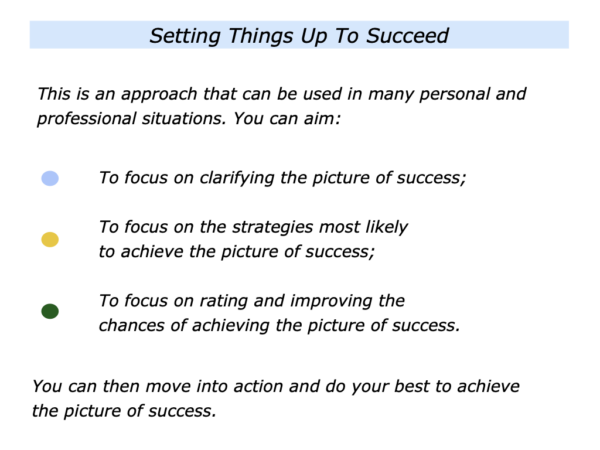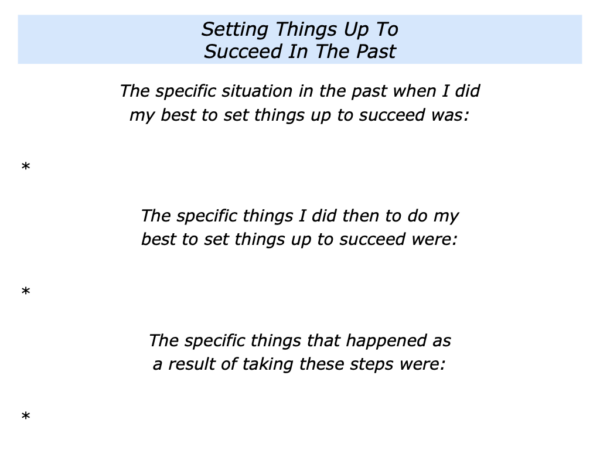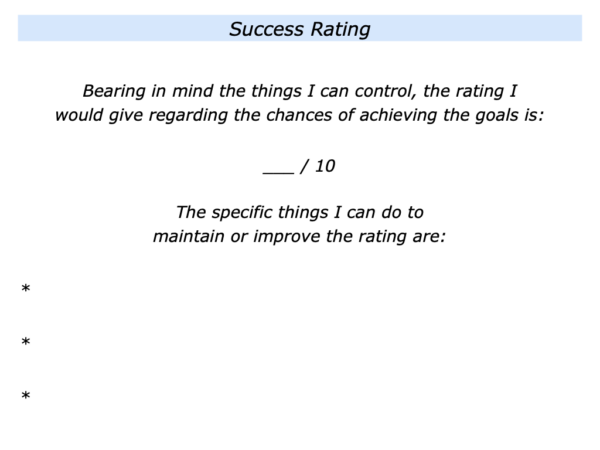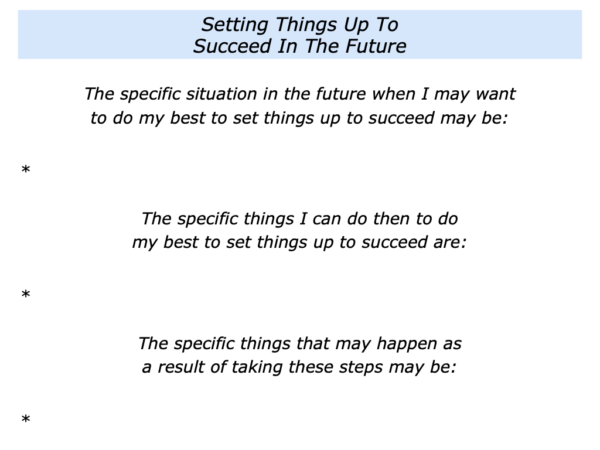
This is an approach that can be used in many situations. The aim is to set things up to increase the chances of success. You may use it to build relationships, do projects, lead a team or do other activities.
You may start by looking ahead to a specific situation. You may then aim: a) to clarify the results to achieve; b) to clarify the strategies for achieving success; c) to rate and improve the chances of success. You can then do your best to achieve success.
Looking back on your life, can you think of a situation when you aimed to set things up to succeed? This could have been in your personal or professional life. What did you do then to make this happen?
If you wish, try tackling the exercise on this theme. This invites you to complete the following sentences.

Imagine that you want to follow some of these steps in the future. Let’s explore how you can do this in your own way.
You can focus on clarifying
the picture of success
You can focus on something you want to do in your personal or professional life. You may want to build a relationship, run a mentoring session, do a specific project, lead a team or do another activity. Looking ahead, you can ask yourself the classic questions.
What is the situation I want to focus on? What is the relationship I want to build, the task to complete, the project to do, the team or organisation to lead, the challenge to tackle or the other activity I want to do?
What are the things I can control in the situation? What are things I can’t control? How can I build on what I can control and manage what I can’t control?
What are the real results I want to achieve in the situation? What is the picture of success? What will be the benefits of achieving these goals? What will be happening that will show I have achieved the picture of success?
Imagine that you have clarified the results you want to achieve. It can then be time to move on to the next stage.
You can focus on the strategies most
likely to achieve the picture of success
You can do your best to set things up to succeed. The steps you take will depend on what you want to do in your life or work.
You may want to do something in your personal life. This could be to build a long-lasting relationship, help your child to thrive, develop a healthy lifestyle, spend time with positive people or do another activity.
You may want to do something in your professional life. This could be to run a counselling session, do satisfying work, tackle a crisis, take over an ailing team, shift the culture in an organisation or do another activity.
Bearing these things in mind, you may explore some of the following themes. These involve clarity, contracting and concrete results.
Clarity
What are the specific results I want to achieve in the situation? What may be the specific results that other people want to achieve? If appropriate, how can we – as far as possible – get win-wins? Bearing these things in mind, what may be the picture of success?
How can I do my best to set things up to succeed? What are the strengths, assets and resources I can use to reach the goals? How can I use these things to do my best to reach the goals?
What are the key strategies I can follow to increase the chances of success? How can I build on my strengths and follow my successful style of working? How can I make use of the other resources?
What are the positive things in the situation? How can I build on these positive things? How can I build on the positive people and positive energies? How can I get some quick successes?
What are the potential difficulties that I may encounter? How can I prevent some of these happening? How can I manage these challenges if, despite everything, they do happen?
Who may be the other people – the person or group of people – involved in the situation? How may these people behave? What may be the positive things they may do? How can I build on these? What may be the not-so-positive things they may do? How can I manage these things?
Contracting
Clear contracting will also be crucial. This includes making contracts with myself and with other people. These will be about ‘What’ we want to achieve and ‘How’ we want to work towards achieving these goals.
Clear Contracting With Myself
What are the clear contracts I need to make with myself about: a) the specific results I want to achieve; b) the specific things I am prepared to do when working towards the goals; c) the specific things I am not prepared to do.
Clear Contracting With Other People
What are the clear contracts I may need to make with other people about: a) the agreed goals to achieve; b) my responsibilities in working to achieve the goals; c) their responsibilities in working to achieve the goals?
What support would I like to help to achieve the goals? How can I do my best to get this support? How can I find solutions if some of the support is not available?
Concrete Results
Let’s return to the key strategies I want to follow. How can I translate my chosen strategies into a clear action plan? How can I get some quick successes?
How can I rehearse following my chosen strategies? How can I rehearse managing any potential challenges? How can I buy time to think if unexpected things happen?
How can I build on what is working? How can I tackle areas for improvement? How can I continue to encourage myself and support other people? How can I do my best to achieve the goals?
Imagine that you have considered how to set things up to succeed. Before embarking on the journey, you may wish to explore the following step.
You can focus on rating and
improving the chances of success
You may have a positive attitude but it is important to be realistic. Whilst doing your, you do not want to ignore warning signs or become a victim. It can therefore be useful to rate the chances of success.
Bearing in mind what you can control, how would you rate the chances of achieving the goals? Rate this on a scale 0-10. Be honest when you do the rating because this will be important when exploring the next step.
Imagine that you have rated the chances on a scale 0-10. You can then describe the specific things you can to do maintain or improve the chances of success.
These may be things that you can do to set realistic goals, get some early successes, get support or take other steps. This involves completing the following sentences.

Imagine that you have done all these things. Make sure the chances of success are at least 7+/10. You may then be in a position to do your best to achieve the picture of success.
Let’s return to your own life and work. Can you think of a specific situation where you may want to set things up to succeed? This could be in your personal or professional life.
Looking ahead, what is the situation you would like to focus on? What are the results you want to achieve in the situation? What are the key strategies you can follow to give yourself the greatest chance of success?
How can you set things up to succeed? How can you follow your chosen strategies? If appropriate, how can you make clear contracts with people? How can you get support?
How can you translate your strategies into action? How can you keep building on what is working? How can you tackle areas for improvement? How can you then do your best to achieve the picture of success?
If you wish, try tackling the exercise on this theme. This invites you to complete the following sentences.



Leave a Reply